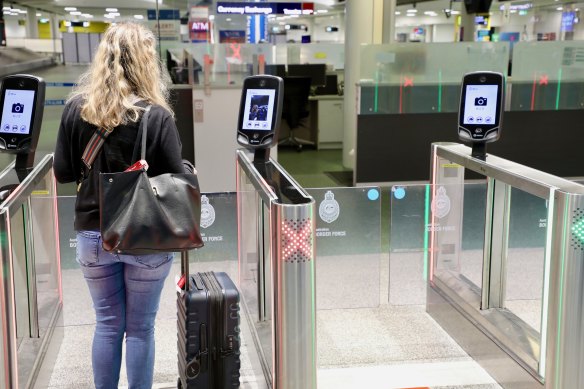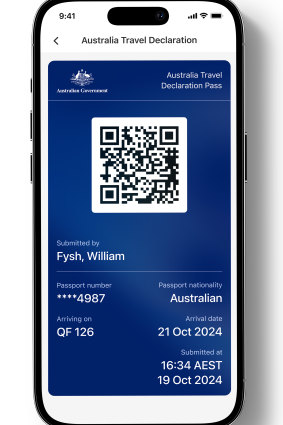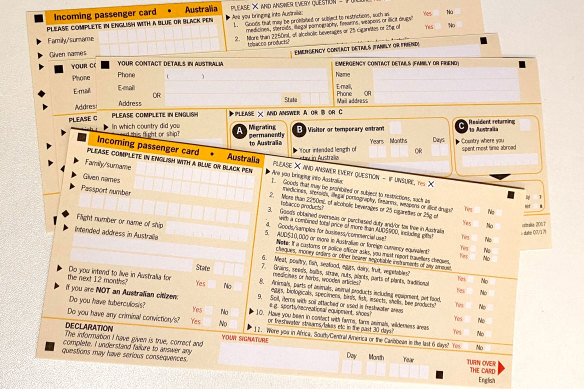Opinion
There’s a big change coming to Australian airports, but it’s not enough
Ben Groundwater
Travel writerHow many countries still use hard-copy immigration forms? How often these days do you have to pull out a pen and fill out a form on the plane before you can go through immigration and customs?
Almost never. There are a few hold-outs, of course, and some countries are still nightmarish to enter.

Australia lags behind other developed nations when it comes to a simple entry process.
But of the developed nations, where old-school paper-based bureaucracy is mostly a thing of the past? I can’t think of any. Not the US, not the UK, not anywhere in Europe. Even Japan has done away with paper forms.
You know which one is the hold-out, right? The country with the yellow forms, the one that still forces passengers to dig around in their bags and then scribble out all of their arrival information in a way that I’m certain almost no one can properly read?
It’s Australia. We still have hard-copy incoming passenger cards (IPCs). But that should soon be a thing of the past.

A digital version of the incoming passenger card is currently being trialled on some Qantas flights.
Australian Border Force (ABF) is currently trialling a digital travel declaration: certain adult passengers flying from Auckland to Brisbane on Qantas flights can now fill one out via the Qantas app, and use the SmartGates at the airport to proceed with only a QR code. The trial will soon include other NZ departure hubs.
This may seem frustratingly slow to some travellers. Like Melbourne’s creaky Myki card system, you always think: you don’t have to reinvent the wheel here guys, plenty of other people have already developed good systems for this. Just copy theirs.
This is also the third time the Australian government has attempted to do this, and right now there are no solid plans to take it outside the Qantas app onto an ABF-designed and run platform. That means that for the foreseeable future, the only way you will be able to access this improvement is by flying with Qantas and using the airline’s app – though, later, other airlines’ apps will join.
Despite these odd stumbling blocks, however, this is good news. The days of filling out those yellow IPCs will eventually be a thing of the past.

Paper incoming passenger cards will (hopefully) soon be a thing of the past.
That got me thinking, too. What else could Australia improve for arriving and departing passengers? In what other areas of air travel do we trail the rest of the developed world?
Ground transport is one that immediately springs to mind.
I was in Tokyo recently and rode the monorail from Hamamatsucho in central Tokyo to Haneda airport, a rapid express journey that took 13 minutes and cost about $5. In Sydney, Central Station to the international terminal takes a little longer – 17 minutes – and costs four times the price.
But that’s about the best that Australia has got. Brisbane’s Airtrain only runs every half an hour at off-peak times and weekends (the last train from the airport is at 10pm) and costs $20 ($11 if you book online in advance).
Perth Airport has a new rail connection, which runs to the city from the Terminal 1 and 2 precinct every 12 minutes and only costs $5, which surely makes it the country’s finest (you’ll need to take a bus to a train station from Terminal 3/4). That makes things all the more embarrassing for Melbourne Airport, one of our country’s major transport hubs, which doesn’t have a train line at all – and possibly never will.
So that’s something we could address. (A regular fast-train service between Sydney and Newcastle would also be nice, but I recognise that’s something of a niche interest of my own.)
What else? The SmartGates system, in Sydney at least, is still a bit of a shambles. I haven’t gone through immigration in Melbourne or Brisbane recently so can’t speak for the systems there, but in Sydney there’s still mass confusion for arriving passengers and long queues despite the supposedly streamlined digital service.
In fact, there are three queues on arrival in Sydney now: at the kiosks for the SmartGates (where the ticket is distributed), then at the SmartGates themselves, and then again to get through customs.
We could see some improvements on the departures side, too. Not that Australian airports are lagging behind the rest of the world here – if you’ve flown through the US, or major European airports, or even Japan right now, you would understand this – but tweaks could still be made.
Queues for domestic departures are still long, particularly around holiday times. This is not so much an airport issue as one owned by airlines, who cut costs with low staffing levels (a measure you would hope translates to lower airfares).
But it’s not reasonable to spend 45 minutes or longer queueing to drop your bag off, even after you’ve checked in – this just encourages more and more people to carry their bags on board, which results in all the overhead space being taken up, and everyone battling to get on board first.
And finally, let’s talk about a personal passion of mine: airport food.
Melbourne Airport has done well here, with recent additions to the standard chain offerings. Acclaimed chefs Scott Pickett and Shane Delia both have restaurants, Collingwood’s Stomping Ground Brewery has an outpost, and there’s an outlet of Brunetti, the classic Carlton cafe and bakery.
The best airports around the world – Japanese airports in particular – have outposts of well-known, local restaurants. Sydney has Luke’s Bistro (run by chef Luke Mangan), but that hardly compares to, say, the eight local ramen outlets at New Chitose Airport in Sapporo.
Still, we’re catching up to the rest of the world. Soon, the paper IPCs will be like paper letters and even paper money: a thing of the past.
Sign up for the Traveller newsletter
The latest travel news, tips and inspiration delivered to your inbox. Sign up now.